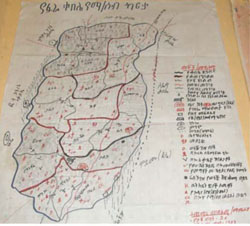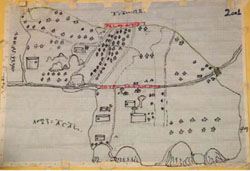Before you can begin to make an effective plan for any health intervention, you must first collect some basic information about the community you serve. For example:
- The size of the total population of your coverage area, and the size of the target population — in this case, clients for immunization.
- A map of your coverage area showing the location of homes, health facilities and other buildings, and geographical features such as paths, ponds, rivers or forests.
Map of a rural area around Fura Health Post in the Southern Nations, Nationalities and Peoples Region (SNNPR) of Ethiopia. (Photo: Basiro Davey)
- The distances (in kilometres, or travel time by walking) between the higher health facility and your health facility, and between the health facility and the furthest members of the community.
Routes that local people can take to reach the Health Post are visible in this map from a rural area near Butajira in the Oromia region of Ethiopia. (Photo: Ali Wyllie)
- Details of transport and communication networks in the area, e.g. roads, and the availability of telephone, radio or TV coverage.
- Knowledge of available energy sources in the area, e.g. electricity generators and supplies of gas, diesel or kerosene.
- The location of potential partners who could assist you, e.g. community associations, employers, private institutions, charitable organisations, etc.
Information like this will help you to anticipate possible problems that could affect your planned activities. Information such as the geography, socioeconomic situation and the health profile of the community you are working in will help you to establish the current situation and work out what problems or challenges are to be expected. If you can identify the possible problems and their causes and their effects in advance, then you may be able to work out potential solutions before the problem becomes serious.


